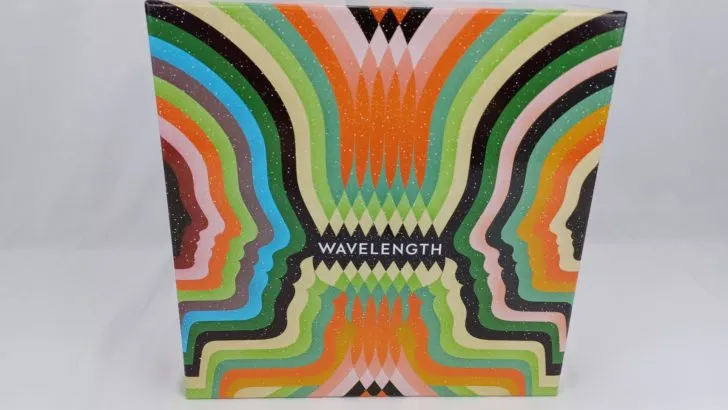Objective of Wavelength
The objective of Wavelength is to give your teammates a clue allowing them to accurately predict where to target on a spectrum. The team that does the best job at this over a number of rounds, wins the game.
Setup for Wavelength
- Place the device (thing with the large dial) into the slot in the middle of the box’s tray.
- Place one head into the slot on the left side that doesn’t have a number next to it. You will place the other head on the right side in the same slot.
- Place the guessing piece in one of the slots in the middle of the tray.
- Divide into two teams with roughly the same number of players. If there aren’t a lot of players, you may consider playing the cooperative game. Check out the Cooperative Mode section below.
- Decide who on each team will be the Psychic (the player who gives a clue) in the first round. This role will rotate throughout the game.
- Chose which team will start the game. The team that goes first keeps their head token in the zero slot. The other team moves their head token to the one point space.
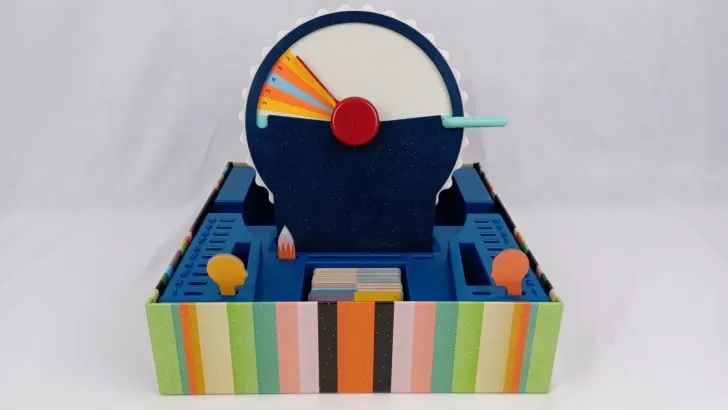
Playing Wavelength
Wavelength in played over rounds. The teams will alternate playing rounds. Each round consists of four phases.
- Psychic Phase
- Team Phase
- Left/Right Phase
- Scoring
Psychic Phase
In the Psychic Phase the Psychic creates a clue for their teammates to hopefully get them to guess the right spot on the spectrum. The Psychic will do all of this without letting any of the other players see what they are doing.
To begin the Psychic will close the screen by rotating the plastic handle until the player can’t see anything on the spectrum.
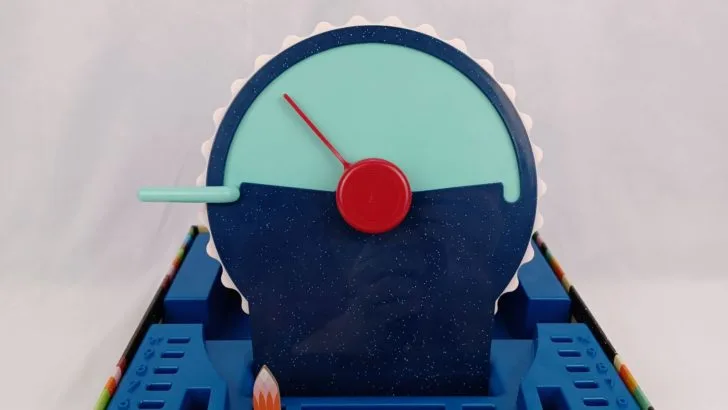
Next the Psychic takes one of the wavelength cards from the deck. Each card is double sided so you can choose which of the two sides you want to use. When you have chosen which side of the card you want to use, place it in the slot in front of the device with the chosen side facing you. You will read the text on the card to the rest of the players.
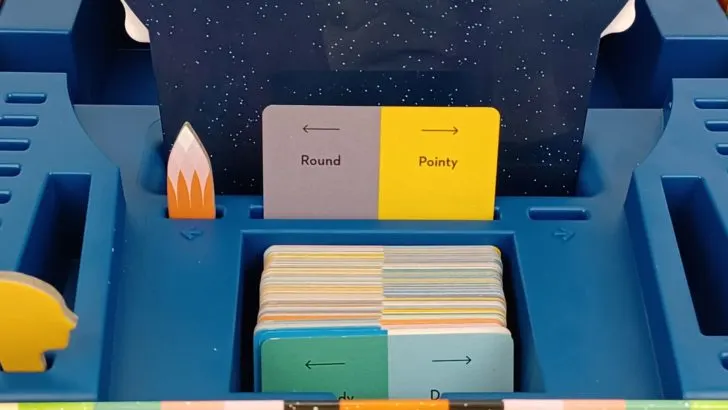
The Psychic then grabs the wheel on the device and turns it for a while to make sure it is in a random position. This randomizes the location of the target that you are trying to get your teammates to guess.
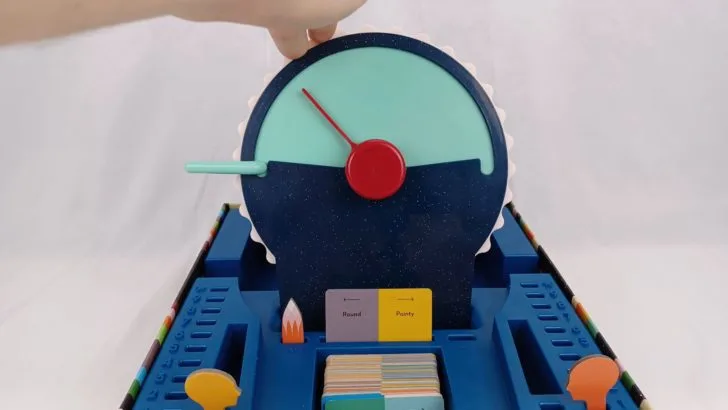
You will then open the screen so you can see the target on the device. The target features five different wedges. The points printed on each wedge tells you how many points that you will score if your teammates choose that section of the spectrum.
If the 4 point wedge is not completely visible, you will have to randomly select a new location for the target. Should some of the wedges be on both sides of the spectrum, you will keep the target where it is. When giving clues you are trying to get your teammates to target the side of the spectrum that the four point wedge is on. You will not score points if your teammates hit a wedge on the other side of the spectrum.
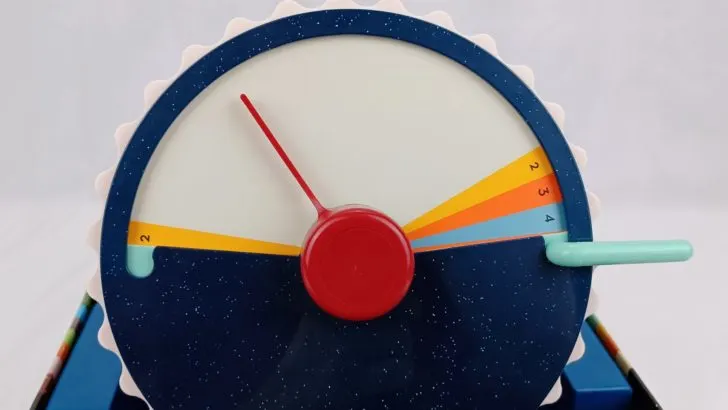
Now that you can see the target location you need to try to come up with a clue that will get your teammates to guess a location on the spectrum corresponding to one of the four wedges of the target area. Preferably you would like them to select the four point area as it will score you more points. When giving a clue you want to think of something on the spectrum between the two concepts printed on the wavelength card for the round. You want to pick something that your teammates will think is in the target area. For more rules/suggestions for giving clues, see the Giving Clues section below. After you have come up with the clue, you will tell the clue to the rest of the players.
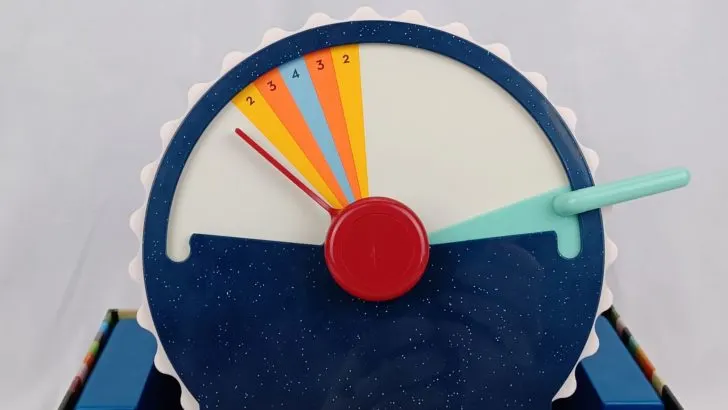
After you have given the clue, you will close the screen so none of the other players can see the target area on the spectrum. You will then turn the device so your teammates can see it. At this point the Psychic cannot communicate at all until both teams have submitted their guess for the round. If the Psychic gives any other information after this point, the players need to decide what the punishment should be. The game recommends that the Psychic draw a new card and redo the whole Psychic Phase.
Giving Clues
When giving clues to your teammates you are trying to come up with something that will get your teammates to guess the correct section of the spectrum between the two extremes printed on the wavelength card.
You can pretty much give any clue. There are a couple of rules that you are recommended to follow in order to avoid breaking the game.
#1 Convey a single thought: When giving a clue it should only be about one idea. You should avoid clues with multiple ideas or a lot of explanatory context. If the clue would force the players to debate two or more sections of the clue separately, it shouldn’t be given.
#2 Don’t Make Things Up: When giving a clue you can use a fictional thing/person/etc if it existed outside of the game you are playing. You are not allowed to make up something on the spot for a clue.
#3 Remain on Topic: Your clue should relate to the concepts printed on the wavelength card. You can’t use one of the words on the wavelength card for its double meaning. For example you can’t create a clue where “hot” is utilized as attractive instead of a high temperature on the hot-cold wavelength card.
#4 Don’t Use Words from the Wavelength Card: Your clue cannot use any words printed on the wavelength card or in the same family of words.
#5 No Numbers: You cannot use numbers, percentages, ratios, or any other number related word to suggest the position of the target. If a number is part of a proper name, you can use a number.
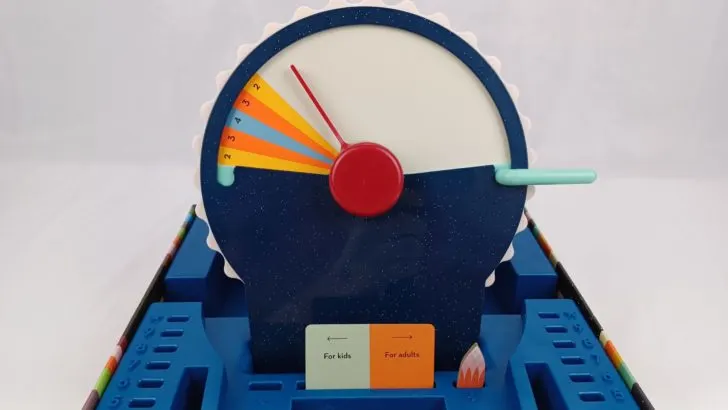
The following rules are optional, but they are recommended to keep to the spirit of the game:
#6 Give Concise Clues: Try to use five or less words for your clue.
#7 No Modifiers: You should try to avoid words that modify other words. Examples include “but”, “almost”, “slightly”, “kind of”, “after ()”, or “”during ()”.
#8 Try to Use Proper Names: When a wavelength card is urging you to use a proper name, you should come up with one instead of a generic clue.
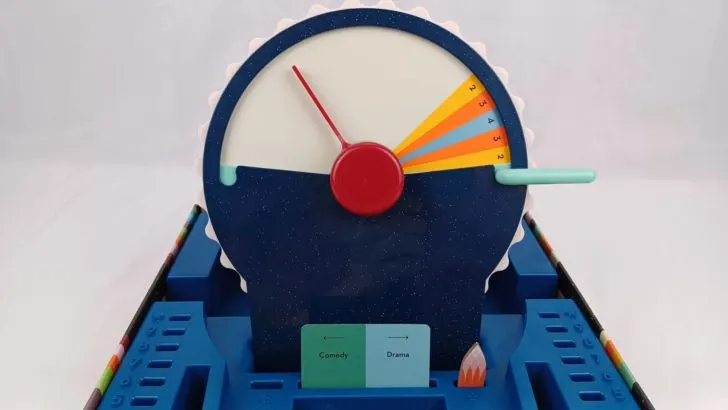
Team Phase
The teammates of the Psychic will then analyze the clue. All of the players can discuss what they think the Psychic meant by the clue. There really aren’t any rules when it comes to how the players discuss the clue. It is recommended that players don’t use numbers or percentages when discussing the clue though.
While discussing, the players on the Psychic’s team can turn the dial to better illustrate what they think. Players can discuss for as long as they want. When all of the players agree to the positioning of the dial, they will tell the other team that they are done. After this point the dial cannot be turned anymore.
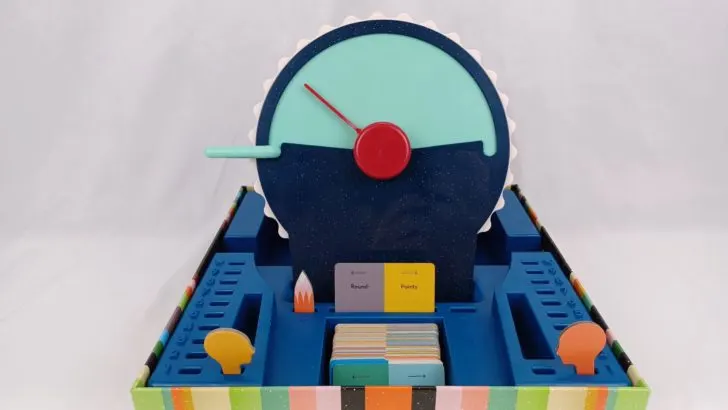
Left/Right Phase
After the Psychic’s team has decided on the positioning of the dial, play passes to the other team.
The other team analyses where the other team placed the dial compared to the clue and the wavelength card. They will need to decide if they think the center of the target (the four point section) is to the left or right of the position of the dial. The players can discuss before making a decision. When they have decided they will place the guess marker in the slot to the left or right of the wavelength card.
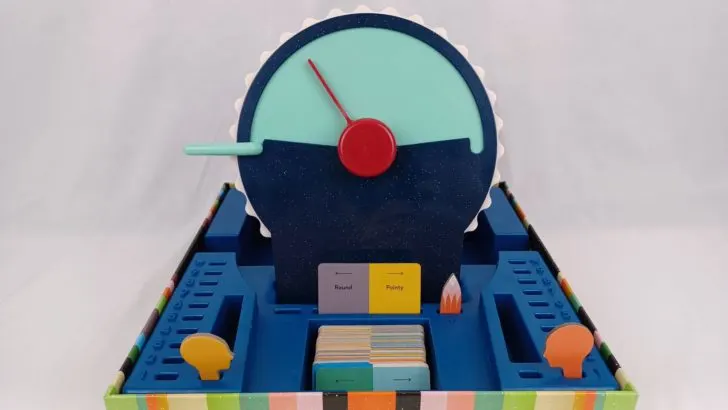
Scoring in Wavelength
Once both teams have finalized their guess, the Psychic reveals the location of the target by opening the screen.
The Psychic’s team figures out if they scored points first. They will look at the position of the dial and the target on the spectrum. If the dial is inside one of the scoring wedges, their team scores points equal to the number printed on the wedge. If the dial is on the edge between two wedges, the team scores the higher number of points. The team moves their scoring marker the corresponding number of spaces on the scoring track.
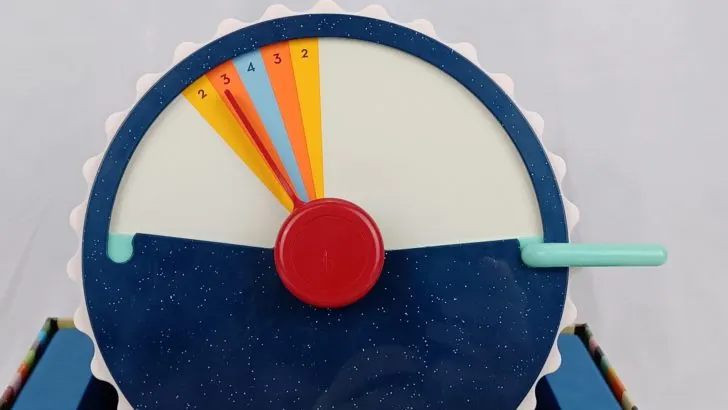
Next you will score the other team’s guess. You will look to see if the center of the target (four point wedge) is to the left or right of the dial. If the team placed their guess marker on the correct side, they will score one point. They will move their scoring marker one space forward on the track. If the Psychic’s team placed the dial on the four point wedge, the other team cannot score points this round.
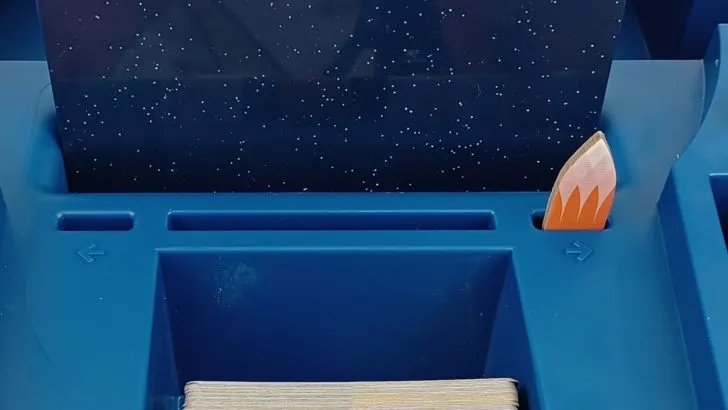
After scoring the next round will start. The other team will play the next round. There is one exception to this if the current team triggered the Catch Up Rule.
Catch Up Rule
If the current team scored four points in the previous round, they have a chance to play again in the next round. If the team scored four points and is still behind the other team, they will get to play the next round as well. A new player will be chosen as the Psychic for the next round though.
Winning Wavelength
The game ends when one of the teams reach ten or more points. The team with the higher score wins the game.
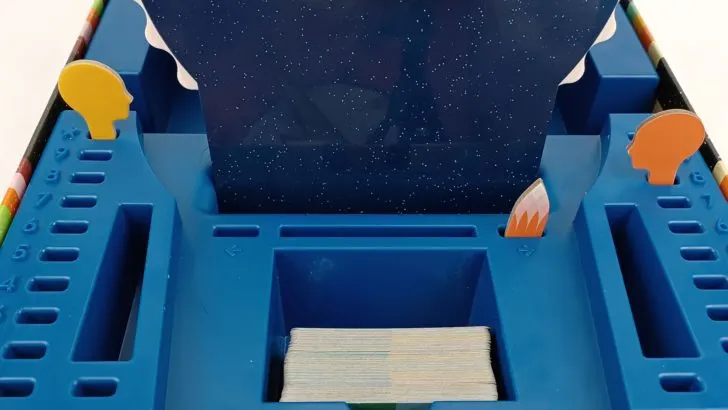
If there is a tie, each team will play one more round. The team that scores the most points wins the game. The teams will keep playing additional rounds until one team has scored more points.
Cooperative Game
Instead of playing as two different teams, you can choose to have all of the players play together. This is recommended if you have between 2-5 players, but can still be used with more players.
Most of the game’s rules stay the same. The differences in the cooperative game are as follows:
To start the game randomly choose seven wavelength cards and place them in the card slot. These are the seven cards you will use in the game.
You will score points in the same way as the normal game. If you hit the middle of the target (four point wedge), you will only score three points. You will get to add another wavelength card to the game though. This means you will get to play another round likely increasing your score.
You will skip the left/right guess phase of the game.
When you have played all of the chosen wavelength cards, the game will end. You will then compare your score to the chart below to see how well you did.
- 0-3 points: Are you sure it’s plugged in?
- 4-6 points: Try turning it off and back on again.
- 7-9: Blow into the bottom of the device.
- 10-12: Not bad! Not great, but not bad.
- 13-15: SO CLOSE
- 16-18: You won!
- 19-21: You’re on the same…wavelength.
- 22-24: Galaxy brain.
- 25+: Head Exploding Emoji.
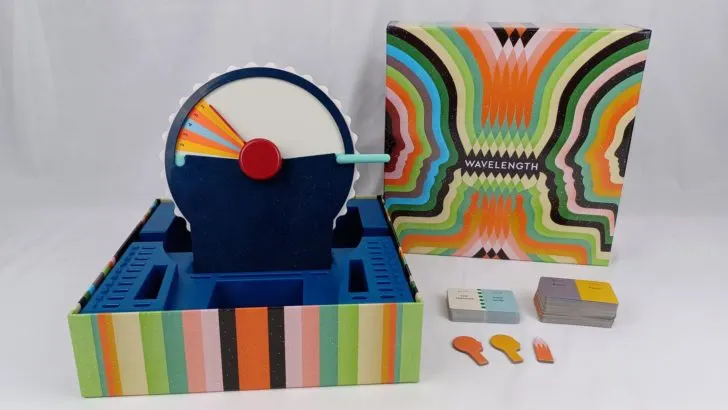
Year: 2019 | Publisher: Palm Court | Designer: Alex Hague, Justin Vickers, Wolfgang Warsch | Artist: Sofie Hannibal, Nan Na Hvass
Genres: Family, Party
Ages: 14+ | Number of Players: 2-12+ | Length of Game: 30-45 minutes
Difficulty: Light-Moderate | Strategy: Light-Moderate | Luck: Light-Moderate
Components: plastic device, 84 Wavelength cards, 42 Advanced cards, 2 head scoring tokens, 1 guess token, plastic tray, instructions
Where to Purchase: Amazon, eBay Any purchases made through these links (including other products) help keep Geeky Hobbies running. Thank you for your support.

